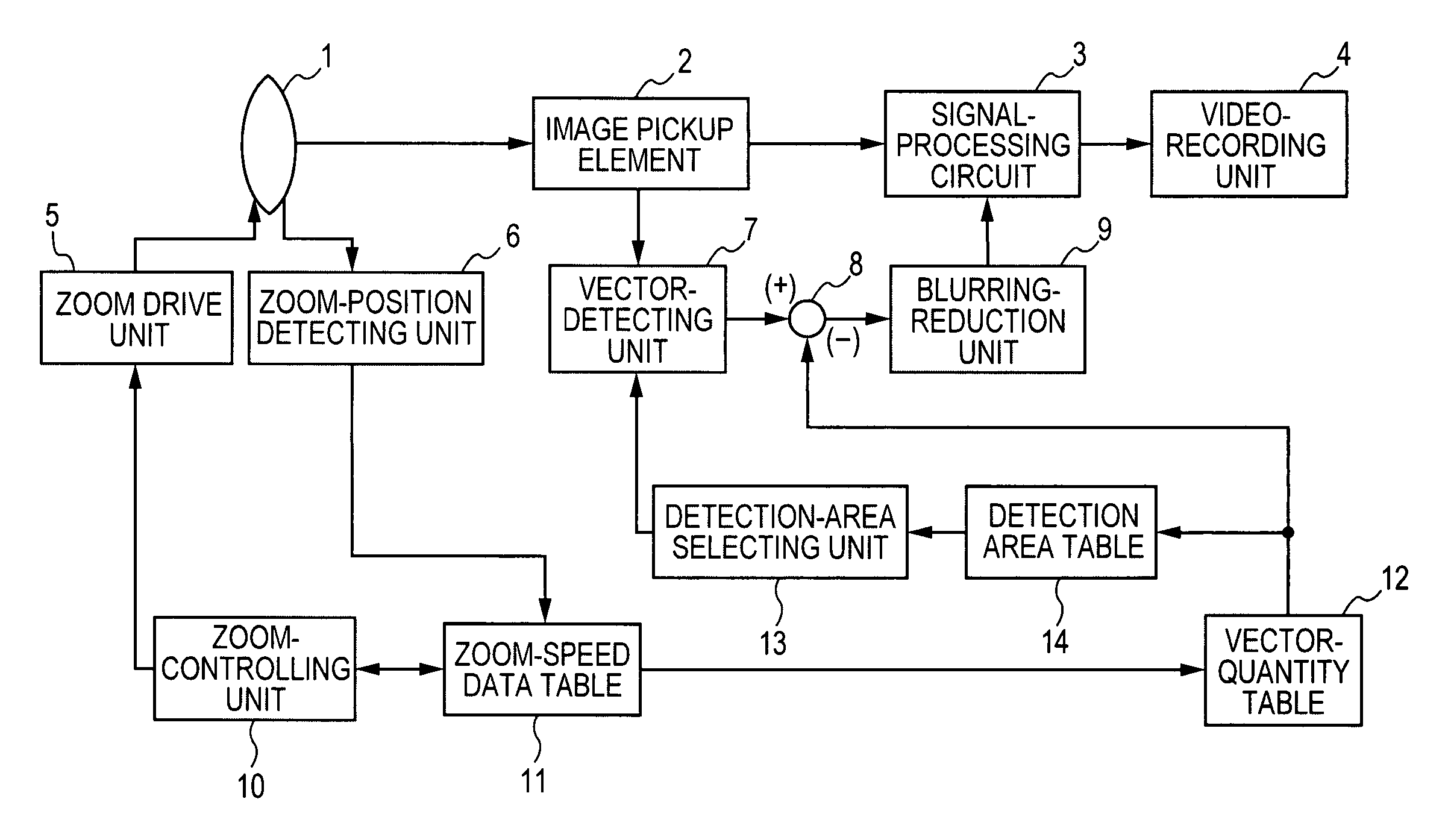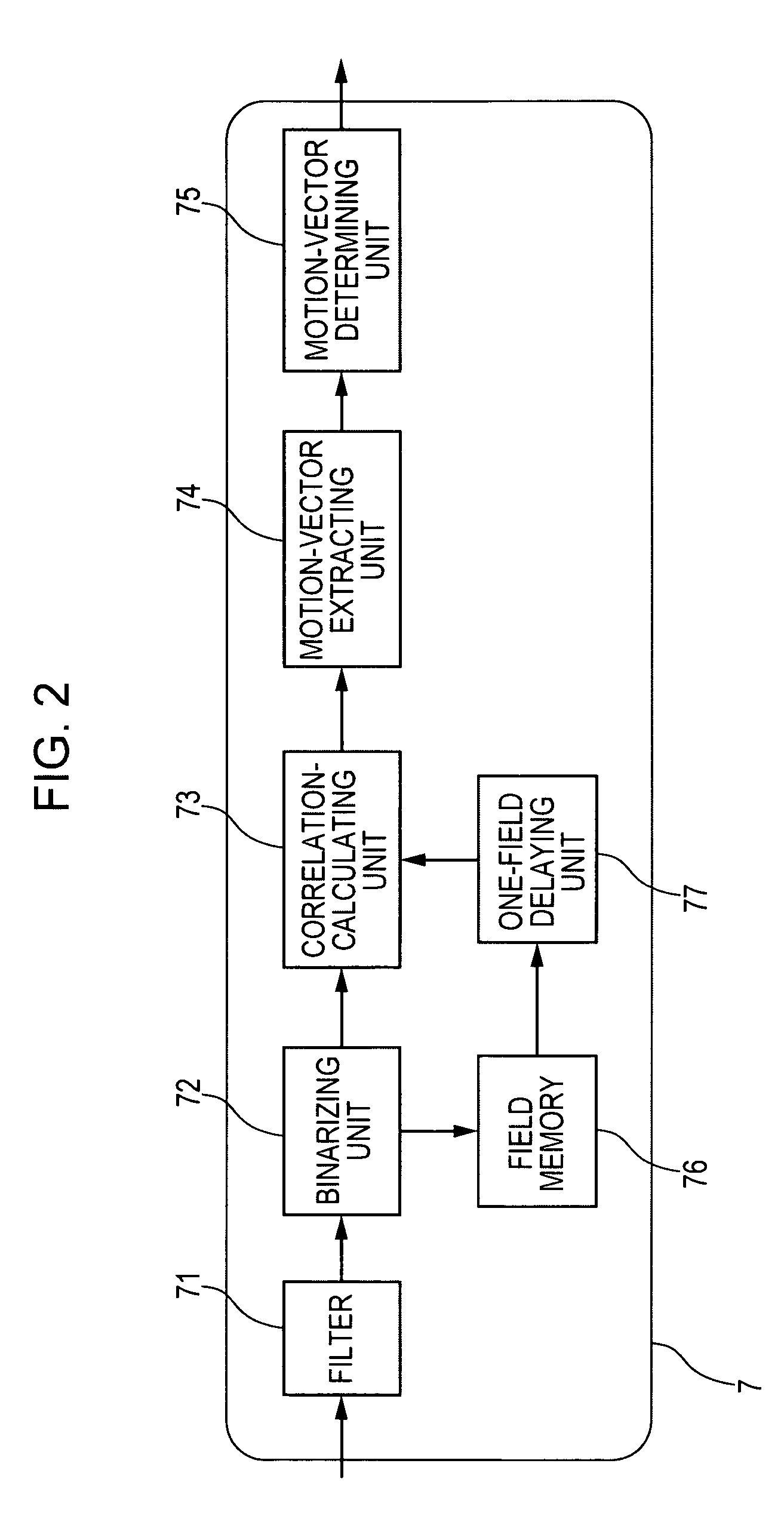Imaging device using a first motion vector in an image that is obtained via an imaging system that can perform zooming and a second motion vector caused by performing zooming of the image
a technology of imaging system and motion vector, which is applied in the direction of television system, instrument, color signal processing circuit, etc., can solve the problems of inability to reduce the blurring of an image on the basis of the detection result, the detection of motion vector caused by the shaking of the device while zooming is performed, and the inability to extract only the motion vector caused by the shaking of the device from the detected motion vector, etc., to achieve the effect of suppressing the blurring of an imag
- Summary
- Abstract
- Description
- Claims
- Application Information
AI Technical Summary
Benefits of technology
Problems solved by technology
Method used
Image
Examples
first exemplary embodiment
[0034]FIG. 1 is a system block diagram showing the structure of an imaging device (e.g., video cameras, digital cameras, optical instruments, other imaging devices as known by one of ordinary skill in the relevant arts and equivalents) having a moving-image shooting function, according to a first exemplary embodiment.
[0035]As shown in FIG. 1, the imaging device includes an optical imaging system 1 that includes an optical element (e.g., a zoom lens) and an image pickup element (photoelectric transducer) 2 that performs photoelectric conversion on an image of a subject formed by the optical imaging system 1 (e.g., a charge-coupled device (CCD) sensor or a complementary metal-oxide semiconductor (CMOS) sensor, other photoelectric conversion elements as known by one of ordinary skill in et relevant art and equivalent).
[0036]The imaging device further includes a vector-detecting unit 7 that detects motion vectors in an image obtained by the image pickup element 2, a zoom drive unit 5 th...
second exemplary embodiment
[0061]In an imaging device that includes an optical imaging system that can change the viewing angle by driving a zoom lens and has an automatic focusing function, which controls the driving of a focus lens included in the optical imaging system, focus may not be maintained. Such a situation occurs when the focus lens cannot be controlled in a case where the zoom lens is driven at a high speed because an automatic focusing operation cannot follow a high-speed zooming operation. This is because focus control is performed by the contrast detection method (the TV-AF method) in an imaging device, such as a video camera. In the contrast detection method, a focal point at which the highest frequency component is achieved is searched for by driving the focus lens with reference to high frequency components in an image.
[0062]In the situation described above, even when the movement of the zoom lens is controlled as illustration in the first exemplary embodiment, motion vectors cannot be dete...
third exemplary embodiment
[0079]In the first and second exemplary embodiments, reduction of the blurring of an image using motion vectors in the middle of a zooming operation is described. It can be determined whether a subject is a moving subject using the methods according to exemplary embodiments which can detect motion vectors in the middle of a zooming operation. In the first and second exemplary embodiments, the motion vector (the third motion vector) caused by shaking of the imaging device is extracted. When the third motion vector is extracted in the same way as in the first and second exemplary embodiments in a case where there is no shaking of the imaging device, the third motion vector is then caused by the movement of a subject.
[0080]When the third motion vector extracted in this way is used, it is determined whether a subject is a moving subject, and then an operation that follows the moving subject, for example, automatic focusing control, can be performed.
PUM
 Login to View More
Login to View More Abstract
Description
Claims
Application Information
 Login to View More
Login to View More - R&D
- Intellectual Property
- Life Sciences
- Materials
- Tech Scout
- Unparalleled Data Quality
- Higher Quality Content
- 60% Fewer Hallucinations
Browse by: Latest US Patents, China's latest patents, Technical Efficacy Thesaurus, Application Domain, Technology Topic, Popular Technical Reports.
© 2025 PatSnap. All rights reserved.Legal|Privacy policy|Modern Slavery Act Transparency Statement|Sitemap|About US| Contact US: help@patsnap.com



